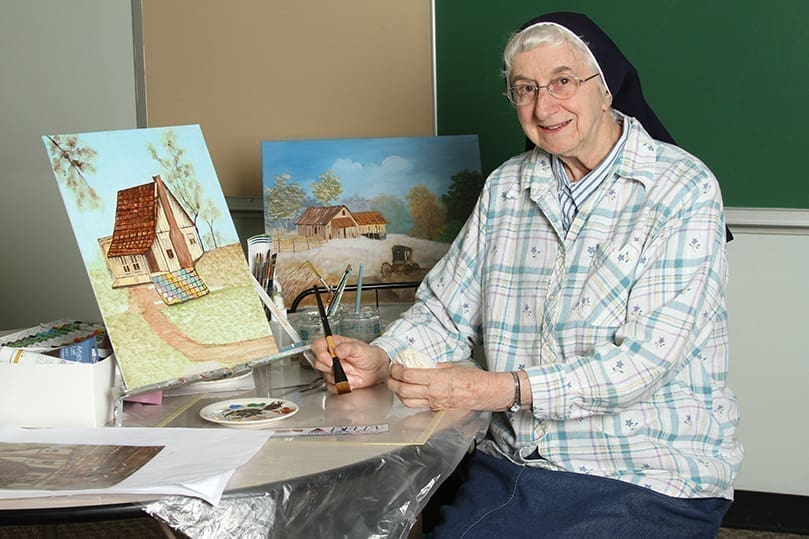 Photo By Michael Alexander
Photo By Michael AlexanderDoraville
Good Shepherd Sister Anita Marks 60 Years A Nun
By ANDREW NELSON, Staff Writer | Published July 19, 2012
Sister Anita Kristofco found herself as a young adult challenged by teenaged girls and youngsters from poor neighborhoods in Philadelphia. Coming from a small town in the western part of the state, she knew little about their homes or life, things like the special hair care needed for black girls was foreign to her.
But she was where she belonged. And 60 years later, her journey as a religious sister continues.
Everyone has a limit, a line, a request that is a step too far. Going to new places, being the odd person out requires steel in the spine, a fearlessness to overcome any obstacles.
And that’s what took Sister Anita from her steel mill hometown, about 40 miles from Pittsburgh.
Here her parents spoke Slovak, the family, like most in the Great Depression, went without a car, and she’d often meet her mom halfway up the hill to carry groceries home.
She attended college in her 40s, traveled to Guam in her 50s, was sent to the Czech Republic to learn the tongue-tying language in her 70s. And today continues her ministry as a volunteer with her order in metro Atlanta.
“I don’t think about the obstacles. I’m praying for what God wants for me. It has always worked out. God is always there,” she said.
The middle of six children, Sister Anita grew up in a modest home, built by her stonemason father and his brothers. Her parents had immigrated to the United States as teenagers from Slovakia. She grew up attending public school, learning the faith from her devout parents and weekly catechism at the parish where the sermon was given in Slovak.
White hair peeks out from a blue veil covering her head. She wears a pendent around her neck with the unique symbol of the Good Shepherd Sisters, a cross with two hearts, along with a shepherd’s crook. She relaxes by painting, which for her is meditative, getting lost in the scene appearing on her canvas.
Two religious sisters came out of her family. A younger sister is a member of the Sisters of Charity of Nazareth congregation.
In the 1940s, she remembered a religious sister telling her and her classmates at religious education to pray to two newly canonized saints, Mary Euphrasia and Gemma Galgani, for direction in her life. She offered prayers to the French-born St. Mary Euphrasia and then “promptly forgot about it.”
Then on April 24, 1952, she entered the religious order of the Sisters of the Good Shepherd, founded by St. Mary Euphrasia. Through the circumstances of her life and prayer, she saw “God was calling me to religious life, instead of marriage.”
Good Shepherd Sisters add a fourth vow to the traditional trinity of poverty, consecrated chastity, and obedience. They take a vow of zeal, a passion directed toward bringing the wounded and the outcast to experience God’s care and love.
Initially, she lived a contemplative life, where the sisters lived behind the walls of a cloister. They served women and girls from Philadelphia. Then the Second Vatican Council changed their ministry, taking Sister Anita and the Good Shepherd Sisters from behind convent walls and into the world to seek out people in need.
She got her bachelor’s degree in 1973 in counseling when she was much older than other students. She followed up later with a master’s degree from Villanova University.
She put her counseling degree to work by serving girls in the care of Good Shepherd Sisters at a diagnostic center in Philadelphia and later in Guam.
Sister Anita joined a handful of other sisters in 1977 who went to the Pacific island to establish a Good Shepherd mission. They went on to open a home for abused women and a second residence for abused children and to assist Catholic Social Services. She’d stay there some 14 years overall. Catholic Social Services remains, serving the native people, the Chamorros, and many ethnic peoples, including Filipinos, Koreans, Vietnamese, U.S. military families, and other islanders. Some are construction workers who were abandoned by their employers there.
Again she volunteered for an overseas project after being home a short time, this time to the Czech Republic to serve people and families in the Eastern European country in the late 1990s. It was cut short when she got ill.
She moved to Atlanta a dozen years ago. Four religious sisters of the Good Shepherd live in the Doraville convent, where they start the day with morning prayer, attend daily Eucharist at Holy Cross Church, and end the day with evening prayer. They also have an hour of meditation each day. She is the volunteer bookkeeper at Good Shepherd Services, three centers that help the Vietnamese and Asian community in metro Atlanta. The skill is something she’s picked up over the years; she kept the books when the Guam project got off the ground.
“If you cannot live by faith in religious life, I don’t think you can last. I came for Jesus and nothing else mattered,” she said.